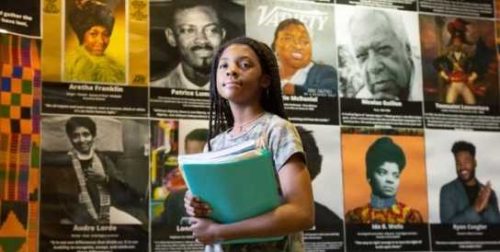Every year, new teachers face a sea of unknowns when they enter their first classroom. Teacher preparation programs are responsible for equipping aspiring teachers to the best of their ability to meet these unknowns, although they sometimes fall short of the mark, sending new teachers into the classroom bereft of so many important skills.
This year brings new challenges and unknowns that we all still struggle to comprehend, as teachers enter the classroom (or enter a virtual classroom from the confines of their dining room table) in the midst of a pandemic.
But the events of this year have also spotlighted a problem that is not new, but is finally receiving the attention it deserves and that many have been fighting for: the way systemic racism pervades every aspect of American society. And perhaps one of the worst perpetrators is the very institution that seeks to right inequities: our education system.
This piece details what prep programs should be doing to prepare teachers, not just for the conversations stemming from the Black Lives Matter movement, but for the critical work, day after day, of providing all kids with an equal opportunity to learn and thrive. Some of these areas are ones NCTQ has long championed, while others are new. Some have been part of many teacher prep programs for years, while others are persistently missing. All are essential.
What teacher prep programs should do and teach:
Teach an understanding of our nation’s history with regard to race.
Most children learn American history in their K-12 education, but it is often a sanitized, white-centered version (or a downright inaccurate one) that glosses over the uncomfortable realities of the treatment of people of color, and focuses instead on the “Great Men” approach to history. Teachers, regardless of the subject they will teach, need to have a more accurate understanding of the role that race played and still does play in our nation. Work like Nikole Hannah-Jones’ The 1619 Project in the
New York Times Magazine can help.
Teach an understanding of our nation’s, our communities’, and our own present relationship with race.
Racism is not a thing of the past; this year’s events (and those of all preceding years) give lie to the notion that our country entered into a “post-racial society.” Nor is racism something that just happens elsewhere, in far-off parts of the country. Prep programs must help teacher candidates unpackage the roots of ideas around privilege and power as related to race, and understand how they remain pervasive today. Understanding how racism persists nationally, in our own communities, and in ourselves helps us confront the current inequities our children face in the present and take action to right these wrongs. Prep programs must help candidates grapple with essential questions around what systemic racism and white privilege are, helping candidates identify examples that they have already seen and opening their eyes to those that are still unseen.
Some useful anti-racist literature that programs may assign include
Why Are All the Black Kids Sitting Together in the Cafeteria (Beverly Daniel Tatum), The New Jim Crow (Michelle Alexander), Me and White Supremacy (Layla F. Saad), How to be an Anti-Racist (Ibram X. Kendi), and White Rage (Carol Anderson).
Teach instructional practices that help all kids succeed.
One of the greatest steps that prep programs can take in service of equity is following the research about how to teach. This is true for instructional strategies, and doubly so for reading (more on that below). There are
clear-cut instructional strategies that teachers can use that help all students absorb and retain information, like posing probing questions and revisiting material over time.
Teach reading instruction!
The inattention by far too many of the nation’s teacher preparation programs in scientifically-based methods of reading instruction is without question their most egregious failing. Too few programs ensure that teacher candidates learn the importance of explicit reading instruction, with an emphasis on phonemic awareness and phonics. Providing reading instruction sequentially can ensure that we do not skip instruction that will support
all children, including those whose language backgrounds are different from our own.
The gap in literacy rates between white students and students of color is stark. The most recent NAEP results show that 77% of white fourth graders read at or above a
Basic level, compared with 55% of Hispanic students and 48% of Black students. Teacher prep programs perpetuate this opportunity gap by not teaching their candidates the science of reading. Case closed.
Teach how implicit biases can impede instruction and create inequities.
Teacher candidates also need to learn how their instruction can produce inequities when they enact their implicit biases on their students. Anti-bias training in isolation
may open candidates’ eyes to issues of systemic racism and help them become more aware of their own biases, which are essential steps. But changing teachers’ instructional habits will require a training that more intentionally ties into teaching. In their daily practice, teachers may unwittingly give students of color inflated grades (indicating lower expectations), call on students of color less often, provide less access to grade-level content, or provide less constructive feedback to their students of color. Over time, teachers (and especially white teachers) tend to be less likely to nominate their students of color for gifted and talented programs or believe they can succeed in college, to name just a few of the many ways that implicit biases translate into educational harm for Black and Latinx students.
Teachers need to be able to identify when their interactions with students are shaped by implicit bias, and to take steps to counteract this. While not all steps are easy, some may be as simple as hiding students’ names when grading their work or using a random system to call on students in class or to select students for class “jobs.”
Prepare candidates to teach a diverse curriculum and to fill in gaps when their district’s curricula do not reflect our nation’s diversity.
Teachers need to be able to teach a curriculum that reflects diversity along many lines: race, socioeconomic status, and gender, among others. Language arts teachers should be familiar with high quality children’s books from a diversity of cultures that speak to varied experiences, and prepared to discuss them with the nuance they merit. History teachers need to be ready to teach history with an eye to whose stories they are telling and what information is left out. When their district uses a curriculum that is not diverse, teachers need to have acquired the expertise to be able to identify gaps and fill them in—something that is hard to imagine many of them doing as, for example, some 49% of elementary preparation programs do not require a course devoted to children’s literature.
Teach and require practice with classroom management.
Students of color are disproportionately subject to exclusionary discipline. And it’s not hard to connect the dots between police in schools and the school-to-prison pipeline. So that teachers don’t rely on extreme measures that remove students from the classroom, prep programs should teach
evidence-based strategies in classroom management and make sure that teacher candidates practice these skills. Effective classroom management focuses on setting clear guidelines around appropriate behavior, preventing or de-escalating problematic behavior, and highlighting what students are doing right. Teachers also need to consider how implicit biases may permeate their own definitions of “appropriate behavior,” and learn to view behavior through a culturally and linguistically diverse lens. While these steps may not entirely prevent the proverbial trip to the principal’s office, knowing how to implement these techniques should drastically cut down this lost learning time (and worse).
Don’t get rid of assessments – for teachers and students – simply because they are the bearers of bad news. Learn to use the information they yield instead.
Licensing tests are getting a bad rap because of the disparity in pass rates between white teacher candidates and candidates of color. Concern about this disparity is well-founded, and certainly invites scrutiny of the tests themselves. But we should also consider how these test scores may be measures of the systemic inequities that start in K-12 education and continue through college. Rather than dismiss these tests wholecloth, let’s take a look at how to address these systemic inequities, and whether better preparation could help more candidates of color succeed on these exams and in the classroom.
Teacher candidates need to learn the value of assessments and how to use them for different purposes. Assessments can be formative, guiding instruction; summative, capturing how much students have learned; and can even promote students’ retention of information. Teachers need to know how to design and deliver assessments, and then how to use the data from them to identify where students struggle and to help them accordingly.
And teachers need to be data literate so that they can analyze trends in their students’ performance that may point to problems in their own practice (including from implicit biases discussed above). Teacher prep programs should underscore that it is very easy to read the data through the lens of our own biases, rather than to reflect on how one’s instruction may be causing some of these gaps to occur.
Give candidates the clinical experiences that will help them be effective.
Novice teachers are more effective when they did their student teaching in a setting similar to their first job, and they are more effective when they did their student teaching alongside effective cooperating teachers. Using student teaching as an opportunity to introduce candidates to successful, high-needs schools will encourage them to work in these settings and to be stronger teachers once they’re there.
Build a bridge between preparation and schools.
Prep programs cannot and should not do this work alone. To be successful, they need to work closely with their local school districts to implement strong and intentional preparation experiences for all candidates. These partnerships provide an opportunity for district leaders to convey their specific needs for candidates, for programs to learn what has worked well and where they need to strengthen their preparation, and for candidates to hone their skills in real classrooms with real students under ongoing supervision and guidance. This connection between districts and preparation programs can also help candidates learn the political, cultural, and historical context of their school community, helping candidates build relationships in these settings.
Underlying all of this: Have the difficult conversations.
Doing this work does not happen in a single lecture or a day devoted to diversity—it weaves through all coursework, all interactions with students and with teacher candidates. It can be messy and uncomfortable. It requires changes in mindsets and in instructional practices. But it is also essential.
This work starts with leaders and faculty of teacher preparation programs. These courageous conversations must start at the top, so that these leaders are able to first intentionally and purposefully address their own biases, and then lead the conversations and hold their staff accountable for doing this work. While not all programs or all staff may feel ready to have these questions with humility and sensitivity, doing so cannot wait.
Program staff, faculty, and student teacher observers will all need some development and support. But through these actions, faculty and staff will develop greater skill in leading discussions (or supporting conversations when their candidates raise these issues) around diversity, equity, and inclusion. Programs may consider adopting a framework so that they can all be speaking the same language.
For some teacher candidates, especially candidates of color, engaging in these conversations is familiar territory, while for other candidates, these discussions are uncharted terrain. Having these conversations helps all teacher candidates talk about issues of race, class, religion, and so on in a professional setting with a diverse group of classmates and colleagues. When teachers don’t know how to talk about these topics, or when they do not feel safe and supported in raising these issues, they avoid them. People need to know that raising challenging issues is not only acceptable but welcome, and that their peers will believe them and will hold themselves accountable for their actions. Programs and teacher candidates do not need to reinvent the wheel; resources such as those from
Teaching Tolerance are available to help.
While introspection is essential, it can also help to hear from students who have been affected by these inequities, and their experiences in K-12 education. With the right structure and facilitation, it can be powerful for the aspiring educators to hear directly from students as well as for the students to tell their stories.
Easy enough, right?
All glibness aside, this list is ambitious, but highlights work that is essential—and it surely falls short of what is needed. What are we missing? What did we get wrong? What is it going to take for teachers to enter the classroom on Day 1 ready to close the opportunity gap, rather than to perpetuate it?
Special thanks to NCTQ Senior Fellows Simone Hardeman-Jones, Kareem Weaver, and Adrienne Williams for their contributions to this piece.
More like this

What’s the Alternative? How some alternative certification programs are shortchanging teachers and students

National Council on Teacher Quality opposes the executive order to dismantle the Department of Education

Black History Month: Learning to read is a civil right


